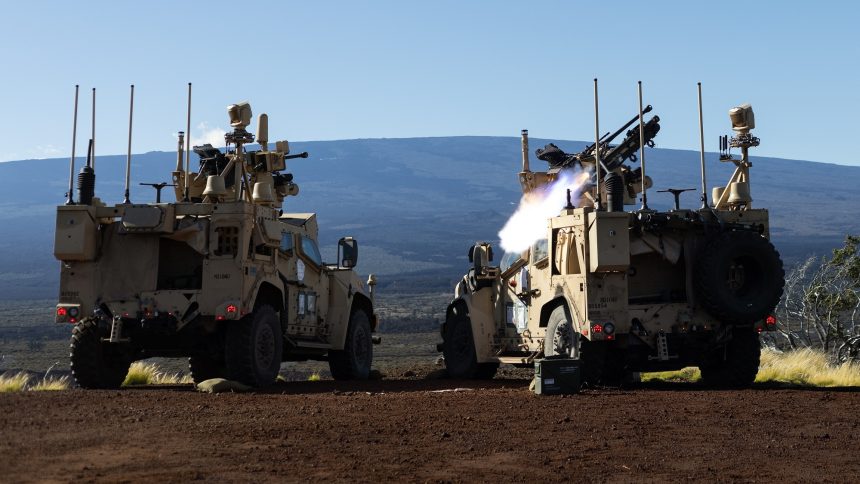MADIS delivers critical defense-oriented capabilities to the USMC and ensures the increased survivability of its formations, being able to work in conjunction with NMESIS by giving it time to emplace, fire, and displace.
The U.S Marine Corps has deployed its newly fielded anti-drone Marine Air Defense Integrated System (MADIS) for this year’s Balikatan 2025 exercise in the Philippines, where it will undergo its second live-fire training, a press release from the 3rd Marine Division said. MADIS will figure during the Integrated Air and Missile Defense (IAMD) event, which is one of the six Combined Joint All-Domain Operations events scheduled throughout the exercise, and will be operated as a Ground-Based Air Defense (GBAD) battery by the 3rd Littoral Anti-Air Battalion (LAAB).
While this is the maiden use of MADIS in an exercise like Balikatan 25 since it was fielded in Dec. 2024, its first live-fire event was held in Jan. 2025, when the 3rd LAAB used it at the Pohakuloa Training Area (PTA) on Hawaii’s Big Island.
The statement about the deployment of the 3rd MLR to the Philippines for Balikatan 25 said the MADIS supports a broader effort to enhance the Philippines Marine Corps’ “coastal defense strategy,” where the 3rd LAAB demonstrates the ability “to find, fix, track, target, engage, and assess aerial targets while partnering with the PMC.”
🇺🇸.🇵🇭US, Philippine forces train with MADIS at Balikatan 25
For the first time, US Marines deploy the Marine Air Defence Integrated System (MADIS) to the Philippines during Exercise Balikatan 25. This joint drill enhances regional security and US-Philippine military cooperation… pic.twitter.com/dVswXJ9xM1
— Caliber English (@CaliberEnglish) April 21, 2025
Balikatan 25
This iteration of the Balikatan bilateral exercise between the U.S. and the Philippines is being held from Apr. 21 to May 9, 2025, seeing the participation of about 9,000 American and 5,000 Philippine military personnel, with nearly all types of aerial, land, naval, amphibious tactical and strategic platforms.
The Philippine military has identified other components of the exercise, including a mock allied counter-attack against an enemy attack on an island, using artillery barrage and standoff missile fires to sink a mock enemy ship, joint navy sails around the disputed South China Sea, and aerial combat surveillance. While the contested region has not been identified, the area could be assumed to be the Scarborough Shoal, where China and the Philippines contest overlapping claims.
“During Balikatan 25, U.S. and Philippine Marines will work “shoulder-to-shoulder” to enhance tactics, techniques, and procedures,” said the USMC.
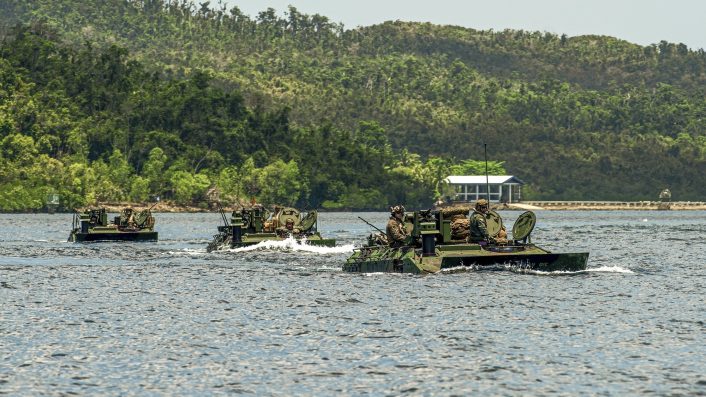
Marine Air Defense Integrated System
Images released on the DVIDS network showed 3rd LAAB personnel and the MADIS at Naval Station Leovigildo Gantioqui in the Philippines on Apr. 19, 2025, attaching the FIM-92 Stinger MANPAD (Man-Portable Air Defense) launchers to the MADIS, prior to Balikatan 25’s start. At least six of the Oshkosh JLTV (Joint Light Tactical Vehicle)-mounted systems could be seen at NS Leovigildo Gantioqui.
The MADIS is a hybrid 30 mm gun, FIM-92 Stinger and jammer counter-drone system, for which the Corps requested $130 million for 13 Increment 1 variants in its 2024 budget request, according to Marine Corps Times. The basic configuration appears to include a 30 mm gun and two FIM-92s on a single turret. Through 2035, the service aims to induct 190 MADIS systems for the 1st, 2nd and 3rd LAABs, the report added.
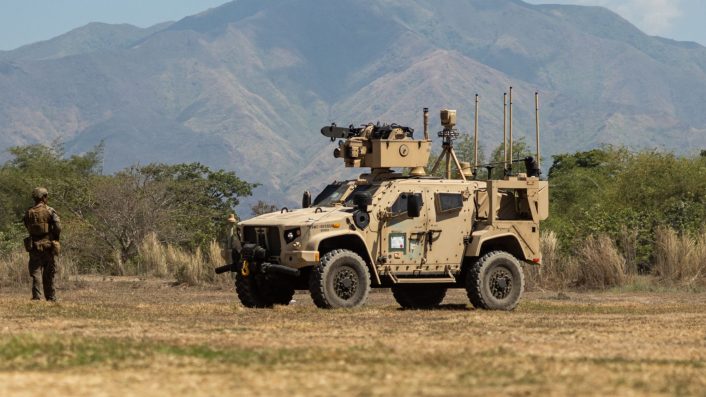
Col. John E. Lehane, commanding officer of the 3rd MLR said in the statement that “the MADIS delivers critical defense-oriented capabilities to 3d MLR and its subordinate battalions.” He further added that, “as a stand-alone weapon system, the MADIS ensures the increased survivability of the elements of our formation and our partners’ formations that are located within its firing range.”
During the Jan. 25, 2025, first live fire of MADIS at PTA, 3rd LAAB fired simulated rounds from JLTV-mounted FIM-92 Stinger in a Service Level Training Exercise. As can be seen in the images, Marines fired the FIM-92 both from the JLTV and conventionally from the shoulder against a “small UAS” used as a “target system.”
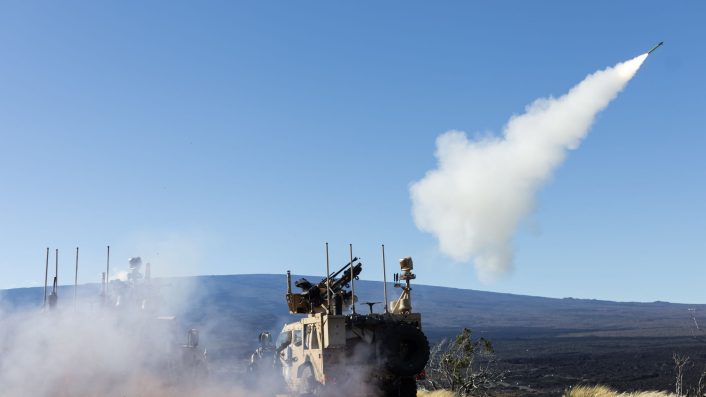
“MADIS increases 3d Marine Littoral Regiment’s tactical flexibility by extending the range of the airspace which 3d MLR is able to sense and defend without support from the Joint Force,” a caption said. That drill also set the conditions for the 3rd MLR’s and its subordinate battalions’ participation in the Balikatan 25 and the Kamandag 9 exercises.
In the latest press release, Lt. Col. Matthew E. Sladek, Commanding Officer of the 3rd LAAB, said the MADIS “continues to exceed expectations, and the more repetitions we get to integrate it with the PMC in training, the more it will enhance our collective lethality.” He further stated that the U.S. and Philippines Marines are expected “to refine collective tactics, techniques, and procedures to bolster the PMC’s coastal defense concept.”
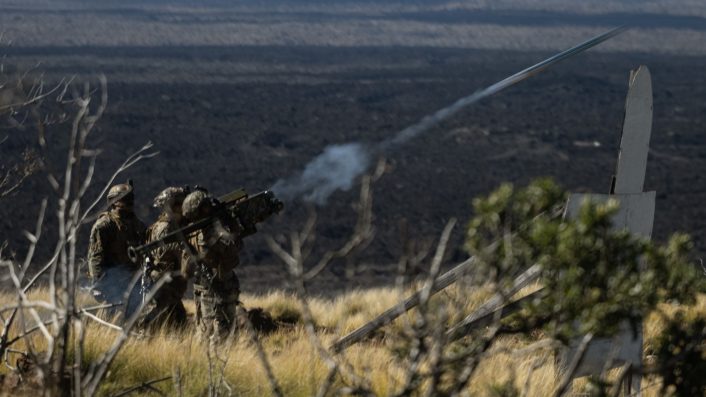
NMESIS
Col. Lehane also touched upon MADIS working “in conjunction” with the Navy/Marine Expeditionary Ship Interdiction System (NMESIS) anti-ship missile system. The two would enable the formation “to conduct maritime strike by giving the Medium-range Missile Battery time to emplace, fire the NMESIS, and displace without fear of being targeted by drones and small unmanned aerial systems,” Col. Lehane mentioned in the press release.
NMESIS is also being integrated into Balikatan 25. A USMC press release said “the NMESIS will be employed during the Maritime Key Terrain Security Operations in Northern Luzon and the Batanes Islands.”
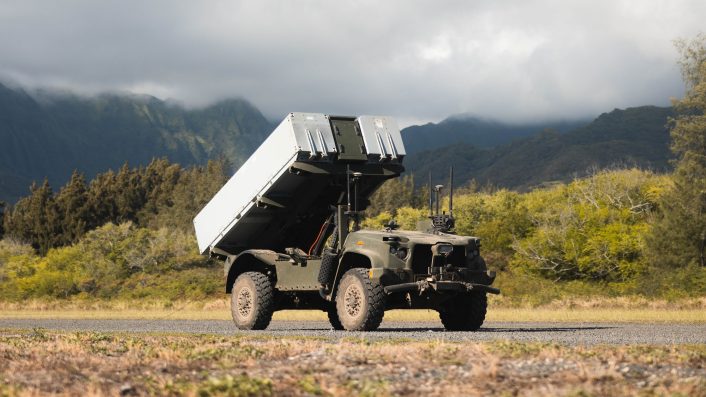
The service further detailed how the employment of the NMESIS would work. “In Northern Luzon, the AN/TPS-80 Ground/Air Task-Oriented Radar, operated by 3d Littoral Anti-Air Battalion’s Tactical Air Control Element – will surveil the surrounding airspace in 3d MLR’s area of operations in support of maritime strike and airspace deconfliction.”
“Through various communication means and methods, the sensing data collected by the G/ATOR will be sent to the Fires and Air Direction Element via tactical data links in support of the commander’s information exchange requirements,” continued the statement. “That sensing data will then transfer to the Battery Operations Center, where it will be processed into tracks and targeting data before making its way back to the Fires EAB.”
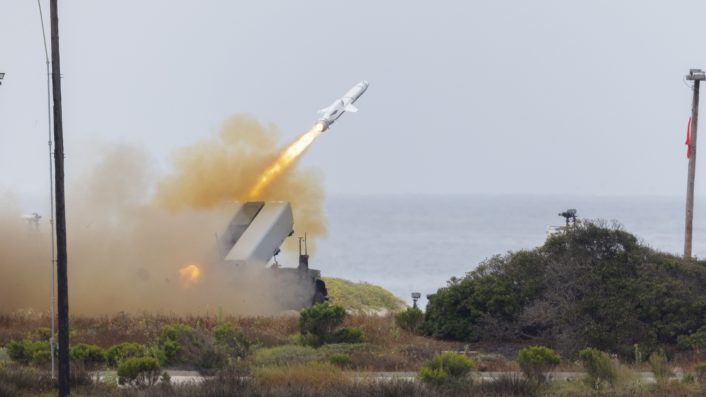
Within the broader Ground-Based Anti-Ship Missile (GBSASM ) concept under the Corps’ Force Design concept, NMESIS enables small, hard-to-detect teams of island-hopping Marines from friendly features in the SCS (South China Sea), conducting long-range anti-shipping fires on the PLA Navy, inside its A2/AD (Anti-Access/Area-Denial) bubble.
The service explicitly mentioned that it will not conduct live-fire with the system: “While 3d LCT’s MMSL Battery will not fire the NMESIS during Balikatan, 3d MLR’s FADE will use the opportunity presented by placing the NMESIS on islands in the Luzon Strait to conduct simulated fires missions.”
U.S. Deploys Anti-Ship Missiles to PH Islands in the Luzon Strait Near Taiwan
The U.S. Marine Corps said on Wednesday that it had sent the Navy-Marine Expeditionary Ship Interdiction System, also known as the NMESIS, to the Philippines,
The Luzon Strait between southern Taiwan… pic.twitter.com/5dMrHpIyZD
— Indo-Pacific News – Geo-Politics & Defense (@IndoPac_Info) April 19, 2025
Firing the NSM (Naval Strike Missile), NMESIS is based on a ROGUE (Remotely-Operated Ground Unit for Expeditionary Fires) system, built on a Joint Light Tactical Vehicle, which allows Marine crews not to be co-located with the launcher. The 3rd MLR (Marine Littoral Regiment), under the 3rd Marine Division, became the first USMC unit to officially receive the system on Nov. 26, 2024, in a ceremony at Marine Corps Base Hawaii.
“The NMESIS provides 3d MLR with enhanced sea denial capabilities and maritime lethality,” a caption said. “The NMESIS provides 3d MLR with enhanced sea denial capability, deepens naval integration, and strengthens deterrence by extending the Joint Force’s ability to target and engage from both land and sea,” further mentioned the statement for the Balikatan 25 exercise.
3d MLR receives NMESIS#Marines with 3d Marine Littoral Regiment, @3d_Marine_Div, formally receive the Navy-Marine Expeditionary Ship Interdiction System on Nov. 26, 2024. pic.twitter.com/7VLQBv4GzT
— III MEF Marines (@IIIMEF) December 2, 2024
MRC Typhon
Additionally, a mid range missile system, which the U.S. Army deployed to the northern Philippines last year, will also be used in the drills this year, Defense News reported. Called the MRC (Mid-Range Capabilities) Typhon, the system was repositioned from the northern Philippine city of Laoag before a disputed SCS shoal, where Chinese and Philippine maritime forces often see tense encounters.
Typhon weapon system (MRC) is great and China is right to be concerned by its capability. (SM-6 & Tomahawk)
2 things:
1) US Navy buys ~125 SM-6 annually.
2) DoD intends to purchase ~300/yr by 2028.
Our missile inventory is shallow. pic.twitter.com/DeomboCSbK
— SubBrief (@SubBrief) March 27, 2025
The MRC Typhon, consisting of the SM-6 (Standard Missile-6), tweaked for surface strikes, and the Tomahawk LACM (Land-Attack Cruise Missile), is one component of the U.S. Army’s Multi-Domain Task Force (MDTF). The other components are the LRHW (Long-Range Hypersonic Weapon) and Lockheed Martin’s PrSM (Precision Strike Missile).
U.S. seeks new depot in the Philippines
Meanwhile, perusing solicitation documents, USNI reported about the Department of the Navy’s efforts to acquire a “climate-controlled” 19,000 to 33,000 square meter facility near Subic Bay and Clark in Philippines by 2026 for storing equipment in a ten-year-long lease. To be utilized for “storage and maintenance of vehicles and vehicle equipment,” its dimensions “dwarfs” the 5,300 square meter warehouse at Naval Support Depot in Subic Bay, poised to support Corps deployments in the region.
The Port of Subic Bay, formerly Naval Station Cubi Point, already teems with heavy U.S. naval activity every Spring during drills with the Philippines. The project would also be larger than the Marine Corps Prepositioning Plan at Norway’s Tromsdal, USNI added.

